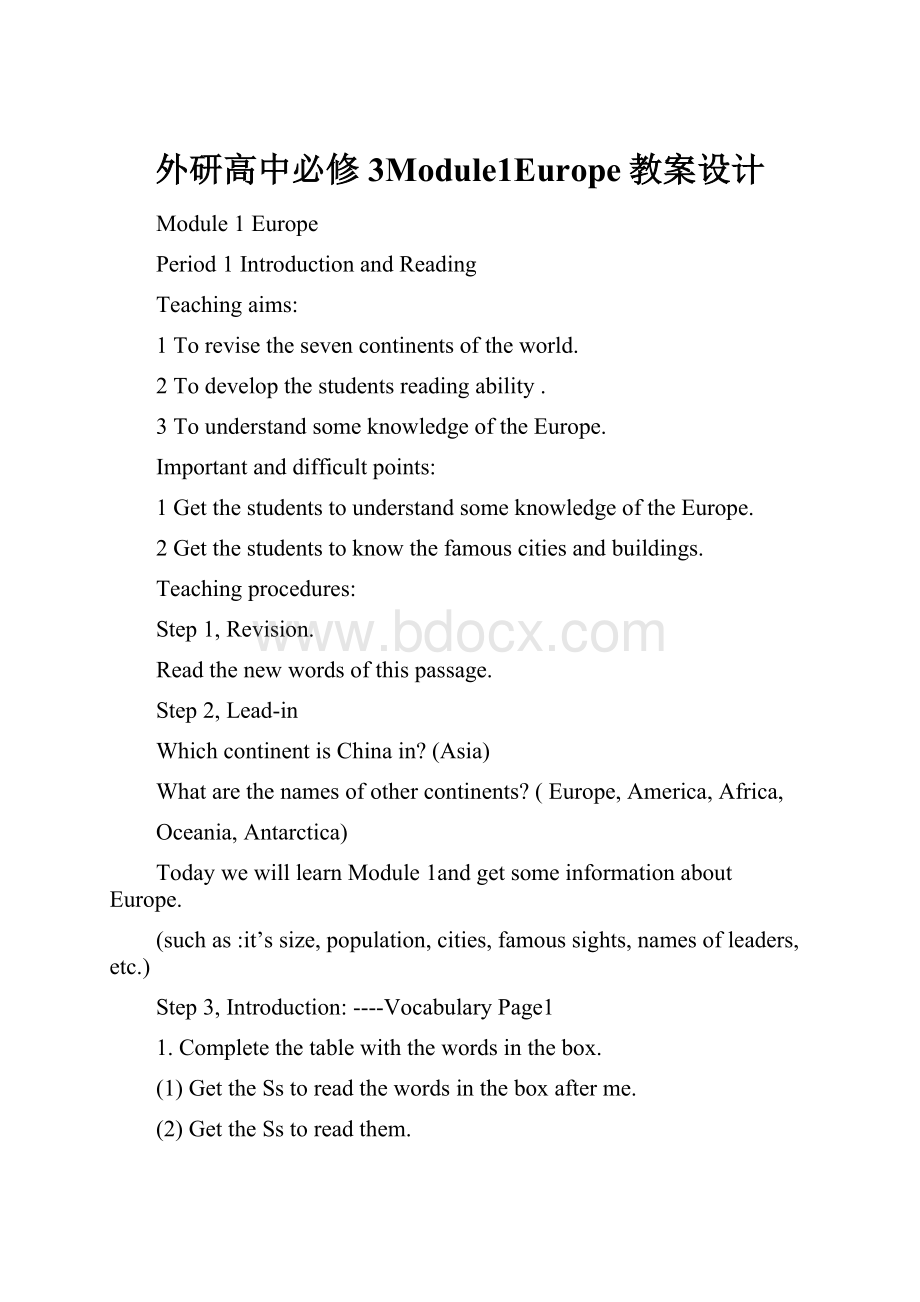外研高中必修3Module1Europe教案设计.docx
《外研高中必修3Module1Europe教案设计.docx》由会员分享,可在线阅读,更多相关《外研高中必修3Module1Europe教案设计.docx(15页珍藏版)》请在冰豆网上搜索。

外研高中必修3Module1Europe教案设计
Module1Europe
Period1IntroductionandReading
Teachingaims:
1Torevisethesevencontinentsoftheworld.
2Todevelopthestudentsreadingability.
3TounderstandsomeknowledgeoftheEurope.
Importantanddifficultpoints:
1GetthestudentstounderstandsomeknowledgeoftheEurope.
2Getthestudentstoknowthefamouscitiesandbuildings.
Teachingprocedures:
Step1,Revision.
Readthenewwordsofthispassage.
Step2,Lead-in
WhichcontinentisChinain?
(Asia)
Whatarethenamesofothercontinents?
(Europe,America,Africa,
Oceania,Antarctica)
TodaywewilllearnModule1andgetsomeinformationaboutEurope.
(suchas:
it’ssize,population,cities,famoussights,namesofleaders,etc.)
Step3,Introduction:
----VocabularyPage1
1.Completethetablewiththewordsinthebox.
(1)GettheSstoreadthewordsintheboxafterme.
(2)GettheSstoreadthem.
(3)GettheSstodividethewordsintothreegroups.Firstgetthemtofinishitbythemselvesandthenchecktheanswerstogether.
2.Checkthemeaningofthewordsandphrases.Readtheinformationandfindthecountriesonthemapabove.
(1)GetsomeSstoreadthewordsandphraseintheboxandgetthemtotellusthemeaning.
(2)Readtheinformationandfindthecountriesonthemapabove.Thatistosay,matchtheinformationwiththecountriesonthemap.
(3)Checktheanswerstogether.
Answers:
(1-f;2-a;3-c;4-e;5-d;6-b)
Step4,Fast-readingpage2
Activity1.Readthepassageandmatchthephotoswiththesedescriptions.
1.A2.C3.D4.B
Step5.Further-reading
Activity3:
Readthepassageandanswerthesequestions.
(1)AsktheSstoreadthepassageagainandanswerthequestions
individually.
(2)Callbacktheanswersfromthewholeclass,havingonestudentaskthequestionandanotheranswerit.
Activity4Decideifthesessentencesaretrue(T)offalse(F)
T:
1,2,5,7,8
F:
3,4,6
Step6.Vocabulary
Activity2Matchthewordsintheboxwiththeirdefinitions.
Answers:
(1)architect
(2)locate(3)landmark(4)writer(5)gallery(6)sculpture(7)ancient
Step7.Discussion.
Discussthefollowingquestionsingroupoffourandchooseoneofthemtoanswerthem.
(1)Whatdidyouknowaboutthesecitiesbeforeyoureadthetext?
(2)Whatnewinformationdidyoulearn?
(3)Whichofthemwouldyoumostliketovisit?
Step8.Homework.
1.Workbook–onPage68.
2.Writeashortpassageaboutyourfavoritecity.
Period2Listening
PronunciationandEverydayEnglish
Teachingaims:
1TolistentothedescriptionaboutthecitiesCardiff,Edinburgh,Valencia.
2Tolearntolistenthespecificinformation.
3Tolearntousequestiontags.
Difficultandimportantpoints:
Getthestudentstoexpressquestiontags.
Teachingprocedures:
Step1.Revision
Checkthehomework.
Step2.Listening
Page3
1)Beforelistening---Readthefollowingquestions.
2)Whilelistening---Listentothetapetwiceandanswerthequestions.
Ex:
1,2,3
3)AfterListening---Checktheanswers.
Ex1:
(1)InScotland
(2)inWales(3)inSpain
Ex2:
AmycomesfromCardiff
HelencomesfromEdinburgh.
CarolscomesfromValencia
CarolsisstudyingEnglish.
HelenisstudyingFrenchandChinese
AmyisstudyingGermanandRussian.
Ex3:
T----1.5F---2.3.4
Step3.PronunciationandEverydayEnglish
Page8
(1)LettheSslookatthequestiontagsintheconversation.
(2)WorkinpairsandpracticetheconversationinActivity1.
(3)Workinpairsandaskrealquestionsorcheckwhatyouknow.
Step4.Homework
Finishofftheworkbook.
Period3CulturalCornerandWriting
Teachingaims:
1TolearnsomethingabouttheEuropeanUnion.
2.Todevelopthestudents’readingskills.
3.TolearntoprepareafactfileonaregionofChina.
Difficultandimportantpoints:
1GetthestudentstolearnthesymboloftheEuropeanUnion.
2Getthestudentstounderstandsomeimportantsentences.
Teachingprocedures:
Step1.Revision
Readthewordsandhaveadictation.
Step2.Leadin
ThereisanimportantorganisationinEurope.Whatisitcalled?
(theEuropeanUnion.)
Nowlet’sgetsomeinformationabouttheEuropeanUnion.
Step3.Fast-reading
Readthepassageandanswerthequestions.
1.WhatistheEuropeanUnion?
2.Howdiditstart?
3.Howmanycountriesbelongtoitnow?
Step4.Furtherreading
Readthepassageagainand
1.FindthenamesofthreefirstmembersandthreenewmembersoftheEuropeanUnion?
(France,Germany,Belgium,)(Australia,Denmark,Finland)
2.Intermsofsizeandpopulation,howbigistheEuropeanUnioncomparedwithChina?
(open)
Step5.Listeningandexplanation
Severalphrases
1.ontheotherhand:
另一方面,反过来说
2.inthe1950s:
二十世纪五十年代
3.littlebylittle:
逐渐的
4.thesecondhalfofthetwentiethcentury:
二十世纪后半期
5.haveapopulationof有多少的人口
Step6.Discussion
1.ChoosearegionofChinaandprepareafactfileaboutit.
1)themaintownsandcitiesintheregion
2)themaingeographicalfeatures(mountains,rivers,lakes,deserts.)
3)themainindustriesand/ormainagriculturalprodudce.
4)themainplacesfortourists.
Step7.Writing
1.Makeaposterdisplayofyourfactfile.
2.ChooseoneofthecitiesfromGreatEuropeanCities.
Step8.Homework
Finishoffyourteachingplans.----languagepoints
Period4Function
GrammarandLanguagepoints
Teachingaims:
1Tolearnnewwordsandexpressionsandlearnhowtousethem.
2Toreviewofthepassivevoices.
3.主谓一致
4.表示方位的介词
Difficultandimportantpoints:
1Getthestudentstoknowhowtousepassivevoices:
一般现在时和一般过去时的被动语态
2Theusageof:
words:
face,design,produce,control
phrases:
besituated/located,littlebylittle,ontheotherhand,comparewithbecauseof,intermsof
Teachingprocedures:
Step1.Revision
Readthesentencesandfindoutwhatgrammararethey?
1Parisisvisitedbymorethaneightmilliontouristseveryyear.
2.TtheSagradaFamiliawasdesignedbyanarchitectcalledAntonioGuadi.
3.Florence’smostbeautifulpaintingandsculptureswereproducedbygreatestartistssuchasLeonardodaVici.
4.Athensisknownasthebirthplaceofwesterncivilization.
5.TheParthenonwasbuiltduringthisperiod.
Step2.Presentation
(1)被动语态
(A)被动语态的基本形式是:
be+过去分词根据时态的不同,be的形式有所变化.
(1)一般现在时的被动语态:
am/is/are+过去分词(口语可用get/become或got/became)
(2)一般过去时的被动语态:
was/were+过去分词
(B)被动语态的基本用法:
不知道或没有必要提到动作的执行者是谁时用被动语态.强调或突出动作的承受者常用被动语态.(有时可省略).
(C)使用被动语态应注意的几个问题.
(1)主动变被动时双宾语的变化.看下列例句
eg:
我朋友在我生日时送我一本有趣的书.
Myfriendgavemeaninterestingbookonmybirthday.
----Aninterestingbookwasgiventome(bymyfriend)onmybirthday.
----Iwasgivenaninterestingbook(bymyfriend)onmybirthday.
(2)主动变被动时,宾补成主补(位置不变);作宾补的省略to的不定时在被动语态中应加to.
eg:
老板让他整天工作.
Thebossmadehimworkalldaylong.
----Hewasmadetoworkalldaylong(bytheboss).
(3)短语动词变被动语态时,勿要掉”尾巴”.
eg:
孩子们被他照顾的很好.
-----Thechildrenweretakengoodcareof(byher).
eg:
要注意一下你的发音和拼写.
-----Yourpronunciationandspellingshouldbepaidattentionto.
(4)情态动词和begoingto,beto,besureto,usedto,haveto,hadbetter等结构变被动语态,只需将它们后面的动词原形变为be+过去分词
(5)当句子的谓语为say,believe,expect,think,know,write,consider,report等时,被动语态有两种形式:
a:
谓语动词用被动语态,动词不定时作主补.
b用作形式主语,真正的主语在后面用主语从句来表示.例如:
eg:
人们说她是个聪明的孩子.
Peoplesayheisasmartboy.
---Itisknowthatheisasmartboy.
---Heissaidtobeasmartboy.
人们都知道纸是最先在中国制造的.
PeopleknowpaperwasmadeinChinafirst.
----ItisknownthatpaperwasmadeinChina.
----PaperwasknowntobemadeinChina.
类似句型有:
Itissaid/know/suggested/believed/hoped/thoughtthat…..
(D)Practice:
Rewritethesentencesinthepassivevoice.Page5Activity2
----answers:
1.Florenceisvisitedbyaboutamilliontouristseachyear.
2.Londonwasvisitedbytenmillionpeoplelastyear.
3.TheMonaLisawaspaintedbyLeonardodaVici.
4.TheMonaLisawasn’tpaintedbyPicasso.
5.TheGreatWallofChinawasbuiltbythousandsofworkers.
(二)主谓一致:
(A).Readthesentencesandanswer:
whathavethewordsfamily/team/andclassgotincommon?
(1)MyfamilylivesinCardiff.
(2)Oursoccerteamisfantastic.
(3)Thewholeclassishere.
(B)句子的谓语动词和句子的主语尽管保持着语法一致,逻辑一致和就近一致原则,但总的来说,句子的主语的确定对于谓语动词的选定起着至关重要的作用。
现见以下简明表:
1.A+with(togetherwith)/alongwith/but;unlike;like/except;including/besides;aswellas+B+v.(与A一致)
2….percent(two–thirds)/therest/all;(a)part;some/most;alot;lots/plenty;part+of+n.(单)+v.(单)
+n(复)+v.(复)
3.manya;every/each;any/either;neither/no…andno…/each…andeach…/every…andevery…+单数名词+单数动词
4.anumberof=(many)+复数名词+v.(pl)
thenumberof+复数名词+v.(单)
5.the+adj.+(人)+v.(pl)
+(物)+v.(单)
6.or/either..or/neither…nor/notonly…butalso+主语+v.(与靠近的主语一致)
(C)Practice
Finishofftheexx2.3.4onPage7
Answers:
Ex2:
plays/has/lives/live
Ex4:
1.)NeitherAmynorHelencanspeakChinese.
2.)EachcountryinEuropehasagoodsoccerteam.
3.)NeitherFranceandGermanyisgoingtosigntheagreement.
4.)Noneoftheclasswant(s)tostudyJapanese.
Step3.Languagepoints
(A)Words
1.face:
V.面对,面向,面临
n.脸
--相关短语:
(1)Befacedwith面对,面临
(2)Facethemusic因做错事承担后果,接受批评。
(3)makeaface/faces向某人做鬼脸
(4)inthefaceof面对,在….面前,不顾
(5)withasmileonone’sface脸带微笑
(6)面对面facetoface(作状语),face–to-face(作定语)
---相关句型:
(1)这房屋面向南。
Thehousefacessouth.
Thehousefacesto/towardsthesouth.
(2)他面临着新的问题。
Hewasfacedwithanewproblem.
(3)我想面对面和我的女友谈一谈。
I’dliketotalkwithmygirlfriendfacetoface.
I’dliketohaveaface-to–facetalkwithmygirlfriend.
2.producevt.生产,创作u.n.农产品
productc.n.产品,产物
productionu.n.生产,产量
(1)Heputforwardaplanforimprovingtherateof________
(2)Theprincipal_______ofthefarmarecattle,sheep,wheat